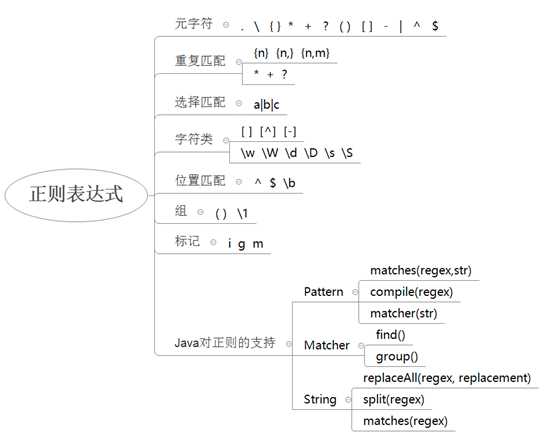标签:replace 结构 图片 结构图 str 第一个 lan 单词 new
Regular Expression 正则表达式 常简称为: regex、正则。正则表达式是一整套约束字符串的语法规则,独立于任何编程语言,
正则表达式 方便、灵活、功能强大,多部分编程语言都对正则表达式提供了支持。我们通常把正则作为一个工具,进行字符串的 校验、获取、替换等操作。

正则表达式中,所有字符分为两类:普通字符和元字符(具有特殊含义的字符)
主要普通字符:小写字母、大写字母、数字、下划线、部分特殊符号、非西文字符等
主要元字符:. \ { } * + ? ( ) [ ] - | ^ $
. 表示任意一个字符(除了换行符)
\ 转移符,用来改变其他字符的含义
如:
\元字符 把元字符转义为普通字符,如\. 把元字符 . 转义为普通字符的 .
\普通字符 把普通字符转义为含有特殊含义的字符,如\n 换行符,\r 回车符,\t 制表符
Java提供了java.util.regex.Pattern 类来创建正则表达式对象
public static boolean matches(regex, str) // 用来判断str是否匹配regex,或者说用来判断str是否符合regex的要求
public static void main(String[] args) { String regex = "abc";// 要求字符串为"abc",str="abc" String str = "abcd"; boolean match = Pattern.matches(regex, str); System.out.println(match);//false }
正则要求字符串为"abc",但实际上字符串为"abcd",不符合正则的要求,所以不匹配,返回false
(注意:此方法要求严格,字符串必须完全符合正则要求才可以)
public static void main(String[] args) { //String regex = ".";// 要求str=任意一个字符 //String str = "b5"; String regex = "\\.";// \. 要求str="." String str = "."; boolean match = Pattern.matches(regex, str); System.out.println(match);//true }
1 Java代码中的 \\ 只表示正则中的 \
2 \n表示换行符,即使用\和n这两个字符组合在一起表示一个换行字符
(x表示一个字符,或者一个字符类,或者一个组等)
x{n} x连续出现n次
x{n,} x至少连续出现n次
x{n,m} x至少连续出现n次,至多连续出现m次
x* x连续出现0次或多次,等同于x{0,}
x+ x至少连续出现1次,等同于x{1,}
x? x出现0次或1次,等同于x{0,1}
public static void main(String[] args) { // String regex = "a{3}";// 要求a连续出现3次,str="aaa" // String str = "a"; // String regex = "a{3,6}";// 要求a至少连续出现3次,str="aaa.." // String str = "aaaaaaa"; String regex = "a?"; String str = "a"; boolean match = Pattern.matches(regex, str); System.out.println(match);//true
}
使用 | 实现选择匹配,即多个选项中任选一个
a|b|c 匹配a或者b或者c
red|blue|green 匹配red或者blue或者green
public static void main(String[] args) { // String regex = "a|b|c";// str="a" "b" "c" // String str = "b"; String regex = "red|blue|green";// str= "red" "blue" "green" String str = "gray"; boolean match = Pattern.matches(regex, str); System.out.println(match);//false }
字符类这个概念不易理解,只要记住它的用法就可以:匹配候选字符的任意一个
[ ] [abc] 匹配abc中任意一个字符,类似 a|b|c
[^ ] [^abc] 匹配非abc的任意一个字符
[ - ] [0-9]、[a-z]、[a-zA-Z] 匹配范围内的任意一个字符
注意:字符类中的元字符(\除外),会被自动转义为普通字符,比如 [.] 等同于 [\.]
\w 代表一个单词字符,类似于[a-zA-Z0-9_],有的语言中也可以匹配中文
\W 代表一个非单词字符,类似于[^a-zA-Z0-9_]
\d 代表一个数字字符,等同于[0-9]
\D 代表一个非数字字符,等同于[^0-9]
\s 代表一个空白字符
\S 代表一个非空白字符
public static void main(String[] args) { // String regex = "hello[abc]";// str="helloa" "hellob" "helloc" // String str = "hellooa"; // String regex = "[0-9]";// str="0" "1"..."9" // String str = "a"; String regex = "\\w";// \w String str = "a"; boolean match = Pattern.matches(regex, str); System.out.println(match);//true }
Java还提供了 java.util.regex.Matcher 匹配器类,用来支持复杂的正则操作
Matcher matcher = Pattern.compile(regex).matcher(str); boolean find = matcher.find();// 查找str中是否有下一个匹配regex的子字符串 String group = matcher.group();// 返回当前和regex匹配的子字符串
//典型用法 while (matcher.find()) { String substr = matcher.group(); // ... }
贪婪匹配:在重复匹配时,默认会匹配尽可能多的字符
非贪婪匹配:在重复匹配后面加上?问号,会匹配尽可能少的字符(并不严格)
public static void main(String[] args) { // String regex = "ab";// 要求str的子字符串substr="ab" // String str = "xabxxabmmabx"; //打印出一个字符串里面的所有的qq邮箱 String regex = "[1-9][0-9]{4,}@qq.com";// qq邮箱的正则表达式写法 String str = "xx12345@qq.comabc123456@qq.commm1234567@qq.com"; Pattern pattern = Pattern.compile(regex); Matcher matcher = pattern.matcher(str); while (matcher.find()) { String group = matcher.group(); System.out.println(group); } }
由于正则表达式和字符串如此相关,Java就为 java.lang.String 字符串类提供了若干可以直接进行正则操作的方法
String newStr = str.replaceAll(regex, replacement);//使用replacement替换全部匹配regex的子字符串 String[] newStrs = str.split(regex);//使用regex作为分隔符切分str boolean match = str.matches(regex);// 等同于Pattern.matches(regex, str)
public static void main(String[] args) { String str = "78ty4589jk78"; // String newStr = str.replaceAll("[0-9]", "*"); // System.out.println(newStr); // String[] parts = str.split("[0-9]+"); // System.out.println(Arrays.toString(parts)); System.out.println(str.matches("78ty4589jk78")); }
正则中的匹配有两种,一种是匹配具体的字符,另一种是匹配特定的位置
^ 匹配文本开始位置
$ 匹配文本结束位置
\b 匹配单词边界(单词开始位置或结束位置)
校验操作时,是否使用 ^和$ 对校验操作没有影响
获取、替换等操作时,一般不使用 ^和$
public static void main(String[] args) { String regex = "\\bhello\\b"; String str = "xx Hello,heLLo helloa "; Pattern pattern = Pattern.compile(regex); Matcher matcher = pattern.matcher(str); while (matcher.find()) { String group = matcher.group(); System.out.println(group); } }
正则使用 ( ) 表示一个组,组可以让若干字符形成一个小整体
(ab) 匹配 ab
(red|blue|green) 匹配 red 或者 blue 或者 green
(red|blue|green) color 匹配 red color 或者 blue color 或者 green color
在匹配时,组的当前 "取值" 会被临时保存起来,方便引用。可以使用 \1 引用第一个组的当前"取值",最多可以引用九个不同的组:\9
(ab)c\1 匹配 abcab
([ab])\1 匹配 aa 或者 bb
(a)(b)\1\2 匹配 abab
public static void main(String[] args) { String regex = "(a)(b)\\1\\2"; String str = "abab"; boolean match = Pattern.matches(regex, str); System.out.println(match); }
标记用来额外指定正则的匹配策略(标记可以不写在正则表达式内)
i 大小写不敏感 insensitive(也可以理解成ignore)
g 全局匹配 global 效果是可以依次的获取到和正则匹配的所有子字符串
m 多行匹配 multiline 效果是^和$可以匹配一段文本中每行的开始和结束位置
在Java中在创建正则对象时可以通过 Pattern.compile(regex, flags) 指定标记
使用Pattern.CASE_INSENSITIVE 常量表示 i
使用Pattern.MULTILINE 常量表示 m
正则操作默认就是全局匹配的
public static void main(String[] args) { String regex = "\\bhello\\b"; String str = "xx Hello,heLLo helloa "; // Pattern pattern = Pattern.compile(regex); Pattern pattern = Pattern.compile(regex, Pattern.CASE_INSENSITIVE); Matcher matcher = pattern.matcher(str); while (matcher.find()) { String group = matcher.group(); System.out.println(group); } }
标签:replace 结构 图片 结构图 str 第一个 lan 单词 new
原文地址:https://www.cnblogs.com/zhuchaoli/p/10342189.html